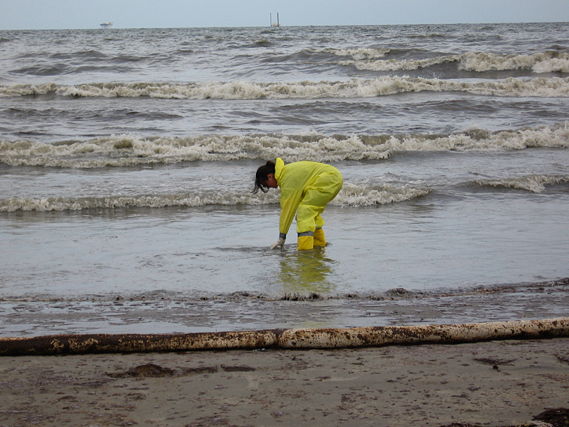A few weeks ago, Gina Lamendella was standing on the deck of the 165-foot Brooks McCall research vessel at the Deepwater Horizon oil spill in the Gulf of Mexico when she learned that she received an Ernest Orlando Lawrence Fellowship.

Lamendella next to the research ship on which she and other Berkeley Lab scientists collected subsurface water samples in an effort to track the Deepwater Horizon oil spill.
“I let out a big ‘woo-hoo!” says Lamendella, a postdoctoral fellow in Lawrence Berkeley National Laboratory’s Earth Sciences Division. “It was a good birthday present too.”
The fellowship was a big surprise and even bigger accolade. It recognizes outstanding people from historically underrepresented groups in emerging scientific fields and provides 50 percent of the recipient’s salary for up to three years.
Her shipboard celebration was short-lived, however. She was soon back to work, helping to collect the smallest of organisms in an effort to track one of the largest environmental disasters in U.S. history.
Lamendella uses molecular genetic tools to study microbial communities in far-flung places, from the human gut, to soil, to the oil-contaminated water and beaches of the Gulf. The idea is to gauge the health of an ecological system, or at least better understand it, by learning how its microbial community functions.
During her three-week stint in the Gulf, she was a member of a Berkeley Lab team led by Terry Hazen of the Earth Sciences Division. Part of her trip was spent aboard the Brooks McCall as the ship followed the underwater plume. Along they way, the team collected subsurface water samples with the goal of measuring the extent to which microbes are degrading the oil.
She also led a similar effort on the beaches of Louisiana’s hard-hit Elmer’s Island. She waded through surf and sand, collecting samples to help determine whether microbes are breaking down the gooey mess.
“This experience really opened my eyes to the fact that I want to be a part of mission-oriented, applied science,” says Lamendella, who joined Berkeley Lab in December after earning her Ph.D. in Environmental Engineering and Science from the University of Cincinnati. She’s a member of Janet Jansson’s lab, an Earth Sciences Division senior staff scientist whose research is aimed at better understanding the role of microbes in their natural environment.
“During the short time that Gina has been in my lab she has demonstrated an impressive ability to work on several demanding projects simultaneously,” says Jansson.
Lamendella’s versatility became clear when she returned from the Gulf and immersed herself in a National Institutes of Health-funded study of Crohn’s disease, an inflammatory disease of the intestines. She’s part of a multi-institutional team trying to determine if there are specific bacteria, genes or proteins that are associated with the disease.
They’re analyzing microbial samples taken from the intestines of a group of Swedish twins. In some cases, both siblings suffer from the disease while in other cases only one sibling has the disease. Some sets of twins are disease free.
For her part, Gina is using bioinformatics tools to comb through the twins’ genomic and proteomic datasets for potential correlations to Crohn’s disease. “Because of this very unique cohort of twins, we can tease out environmental factors and really work to identify biomarkers of the disease,” says Lamendella.
Adds Jansson, “Gina has an unusual complement of skills that are very valuable for my research area, ranging from field expertise to bioinformatics and biostatistics.”
Her skills will come in handy in another project she’s involved in that focuses on soil, which hosts one of the most complex microbial communities known. The Great Prairie metagenome is currently being sequenced as a pilot study at the Joint Genome Institute (JGI). The project requires analyzing more than 200 billion bases of sequence data, which is an enormous dataset even by JGI standards. The project’s dividends could be just as enormous, perhaps leading to a gene-level understanding of the role of soil microbes in the carbon and nitrogen cycles.
Inspired by this potential, Lamendella wants to gain even more programming skills to further augment her ability to take on the big questions in biology.
“Biology is becoming very data intensive,” says Lamendella. “Tomorrow’s advances will come from our ability to both understand the underlying science and extract the new information from the data.”
